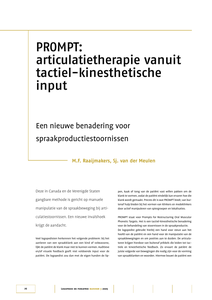Werk jij als vakleerkracht al samen met de intern begeleider van de school? Weet jij wat deze professional voor jou kan betekenen? En is er een jeugdarts betrokken als een kind een ernstige motorische achterstand heeft? In Amsterdam is er een samenwerking tussen de zorgprofessionals en de professionals op basisscholen die meedoen aan de Ondersteuningsroute Bewegen en Motoriek (OBM). In dit verhaal lees je welke meerwaarde deze samenwerking heeft en kom je op ideeën hoe jij op die manier als vakleerkracht ook bewegingsachterstanden kan tegengaan.
DOCUMENT

Onze sport- en beweegsamenleving is fundamenteel aan het veranderen. Schoolgaande kinderen bewegen steeds minder. De gevolgen van bewegingsarmoede zijn merkbaar. Per generatie nemen de motorische vaardigheden af en neemt het overgewicht toe. In dit artikel een pleidooi voor samenwerking met partners vanuit verschillende perspectieven: boundary crossing.
DOCUMENT

PROMPT is a tactile-kinesthetic approach for assessment and treatment of speech production disorders. PROMPT uses tactile-kinethetic cues to facilitate motor speech behaviors. Therapy is structured from basic motor speech patterns with much tactile-lkinesthetic cueing, towards complex motor speech activities with less cueing. This article describes the purpose and contents of PROMPT assessment and therapy.
DOCUMENT

PROMPT wordt toegepast als een methode bij de verberting van spraakproductie bij volwasssenen en kinderen met diverse stoornissen. Het gaat om een nieuwe benadering waarbij de logopedist van buitenaf hulp biedt bij het vormen van klinkers en medeklinkers door het actief manipuleren van spiergroepen en lokalisaties.In de traidotionele spraaktherapie wordt het spraakprobleem vaak gezien als een reeks van foneemafwijkingen, terwijl de motorische benadering van PROMPT het spraakprobleem juist beschouwt als een reeks van bewegingsafwijkingen. het artikle beschijrft de uitgangspunten en opzet van deze voor Europa nog vrij nieuwe therapie.
DOCUMENT
The studies reported on in this thesis addressed the development of suckingpatterns in preterm newborns. Preterm infants often have problems learningto suckle at the breast or to drink from a bottle. It is unclear whether this isdue to their preterm birth or whether it is the consequence of neurologicaldamage. From the literature, as well as from daily practice, we know thatthere is much variation in the time and in the way children start suckingnormally. Factors such as birth weight and gestational age may indeed berisk factors but they do not explain the differences in development. A smallspot-check proved that most hospitals in the Netherlands start infants onoral feeding by 34 weeks’ post-menstrual age (pma). By and large the policyis aimed at getting the infant to rely on oral feeding entirely as soon aspossible. The underlying rationale is to reduce the stay in hospital, and theidea that prolonged tube-feeding delays or even hampers the development ofsucking.
DOCUMENT

Dementie komt veel voor, vooral op hogere leeftijd neemt de kans aanzienlijk toe. Dementie is een syndroom dat wordt gekenmerkt door een duidelijke cognitieve achteruitgang ten opzichte van een eerder niveau van functioneren, in een of meer cognitieve domeinen (complexe aandacht, executieve functies, leervermogen en geheugen, taal, perceptueel-motorisch of sociaal cognitief). Dementie is een overkoepeldn verzamelbegrip met vele verschillende oorzaken. De meest voorkomende oorzaken zijn de ziekte van Alzheimer en vasculaire dementie, daarnaast komen frontotemporale dementie, parkinsondementie en de dementie met lewy lichaampjes (lewy-body dementie) voor. Naast een algemene inleiding over dementie wordt in dit hoofdstuk het fysiotherapeutische onderzoek en behandeling bij dementie besproken.
DOCUMENT
BACKGROUND: People with severe or profound intellectual and motor disabilities (SPIMD) experience multimorbidity and have complex health needs. Multimorbidity increases mortality, decreases functioning, and negatively influences quality of life. Information regarding patterns of multimorbidity in people with SPIMD may lead to proactive prevention, specifically detection and treatment of physical health problems at an early stage and prevention of secondary complications.AIM: The aim of this study was to explore patterns of multimorbidity in individuals with SPIMD.METHODS AND PROCEDURES: Data from medical records and care plans on reported physical health problems of 99 adults with SPIMD were analysed. To explore the co-occurrence of physical health problems, cross tabulations and a 5-set Venn Diagram were used.OUTCOMES AND RESULTS: The most common combination of two physical health problems comprise the most prevalent physical health problems, which included visual impairment, constipation, epilepsy, spasticity, and scoliosis. These five issues occurred as a multimorbidity combination in 37% of the participants. In 56% of the participants a multimorbidity combination of four health problems emerged, namely constipation, visual impairment, epilepsy, and spasticity.CONCLUSIONS AND IMPLICATIONS: People experiencing SPIMD have interrelated health problems. As a consequence, a broad variety of potential interactions between physical health problems and their treatments may occur. Identifying multimorbidity patterns can provide guidance for accurate monitoring of persistent health problems and, early detection of secondary complications. However, the results require confirmation with larger samples in further studies.
DOCUMENT
Taalexperts zien vaak motorische problemen bij kinderen met taalontwikkelingsstoornissen. Aan de andere kant zien bewegingsexperts vaak taalproblemen bij kinderen met motorisch stoornissen. Kinderen met taalstoornissen én motorische stoornissen hebben een dubbele handicap. Vroege identificatie en behandeling van kinderen met taal- en motorische stoornissen is van cruciaal belang om hun kansen op maatschappelijke participatie te vergroten.Taalstoornissen en motorische stoornissen kunnen al goed worden opgespoord. Echter, taalexperts en bewegingsexperts geven aan handvatten nodig te hebben om in een vroeg stadium onderscheid te kunnen maken tussen hardnekkige neurologische stoornissen en tijdelijke achterstanden in taal en motoriek. Het maken van dit onderscheid is belangrijk voor de keuze van het juiste zorgtraject.De verwachting is dat taalproblemen in combinatie met motorische problemen kan duiden op een onderliggende neurologische stoornis. Deze informatie zou zowel taalexperts als bewegingsexperts in staat kunnen stellen om al voor het vijfde levensjaar een neurologische ontwikkelingsstoornis in taal en/of motoriek te identificeren en te onderscheiden van niet-neurologische taal- en motorische achterstanden.
Children with speech sound disorders (SSD) have speech disorders due to problems in articulation, phonology, execution (eg. dysarthria), planning (eg. apraxia), orofacial anomalies (eg. cleft palate) or hearing impairment (ASHA). How do children with speech sound disorders perform on language and motor (experimental) tests compared to typically developing children?
LINK